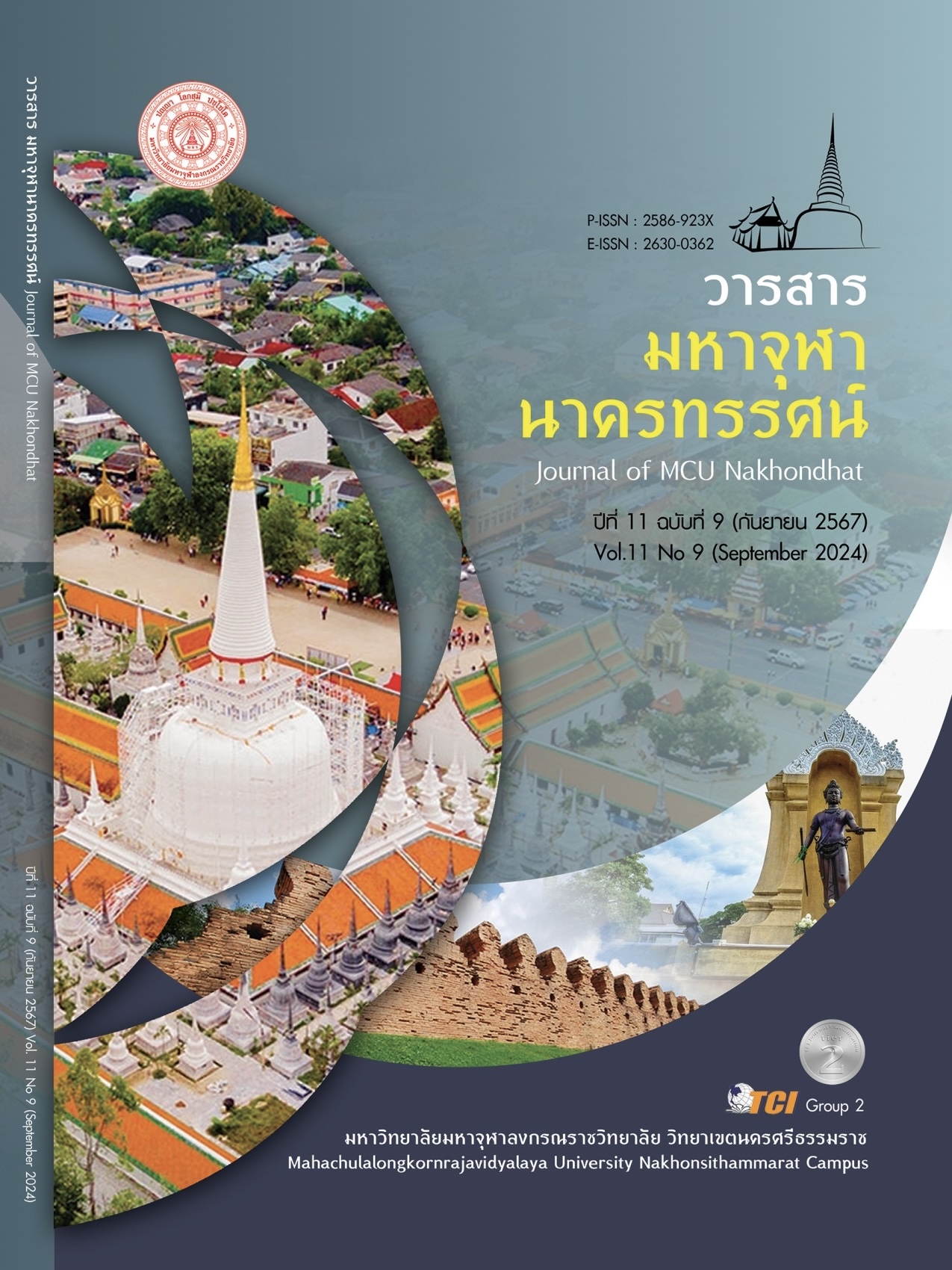แนวทางการปรับปรุงประสิทธิผลของความสามารถพิเศษการแนะนำมหาวิทยาลัยในกวางสี
Main Article Content
บทคัดย่อ
การวิจัยครั้งนี้มีวัตถุประสงค์เพื่อพัฒนาแนวทางการปรับปรุงประสิทธิผลของความสามารถพิเศษการแนะนำมหาวิทยาลัยในกวางสี โดยใช้รูปแบบการวิจัยแบบสำรวจ ประชากร ได้แก่ ผู้บริหาร 269 คนจาก 8 มหาวิทยาลัยในกวางสี โดยใช้การสุ่มตัวอย่างอย่างเป็นระบบและสุ่มตัวอย่างแบบวาดจากมหาวิทยาลัย ผู้ให้สัมภาษณ์ในการวิจัยครั้งนี้เป็นผู้บริหาร จำนวน 16 คน จากมหาวิทยาลัยละ 8 แห่ง เลือกผู้บริหารจากแต่ละมหาวิทยาลัยจำนวน 2 คน เครื่องมือวิจัย ได้แก่ แบบสอบถามประมาณค่า 5 ระดับ มีความเชื่อมั่นอยู่ที่ระดับ .93 สถิติที่ใช้การวิเคราะห์ข้อมูล ได้แก่ ค่าร้อยละ ค่าเฉลี่ย ส่วนเบี่ยงเบนมาตรฐาน และการวิเคราะห์เนื้อหา ผลการวิจัย พบว่า 1) สถานการณ์การแนะนำผู้มีความสามารถพิเศษทั้ง 5 ด้านในปัจจุบันอยู่ในระดับปานกลาง เมื่อพิจารณาผลการวิจัยด้านนี้ตั้งแต่ค่าเฉลี่ยสูงสุดไปจนถึงต่ำสุด มีดังนี้ ค่าเฉลี่ยสูงสุด คือ การแนะนำรูปแบบและขั้นตอน รองลงมา คือ แหล่งข้อมูลการวิจัยทางวิทยาศาสตร์ และกลไกการประเมินเป็นค่าเฉลี่ยต่ำสุด 2) แนวทางการปรับปรุงประสิทธิผลการแนะนำผู้มีความสามารถ 5 ด้าน ประกอบด้วย 33 มาตรการ มี 6 มาตรการ ในการสนับสนุนทรัพยากรการวิจัยทางวิทยาศาสตร์, 6 มาตรการ ในการเพิ่มเงินเดือนและสวัสดิการ 7 มาตรการ ในการเสริมสร้างกลไกการประเมิน, 7 มาตรการ ในการสนับสนุนมาตรการสนับสนุนผู้มีความสามารถ, 7 มาตรการ ในการส่งเสริมรูปแบบและขั้นตอนการแนะนำ 3) ผลการประเมินความเหมาะสมและความเป็นไปได้ของแนวทางการปรับปรุงประสิทธิผลการแนะนำผู้มีความสามารถอยู่ในระดับสูง โดยการบริหารจัดการที่เป็นเลิศควรสนับสนุนและพัฒนาคุณภาพแหล่งข้อมูล การวิจัยทางวิทยาศาสตร์ กลไกการประเมิน ซึ่งมีเป้าหมายสำคัญ คือ การพัฒนาและยกระดับคุภาพทรัพยากรมนุษย์ที่มีความสามารถพิเศษได้ใช้ความสามารถให้เกิดประโยชน์สูงสุด
Article Details

อนุญาตภายใต้เงื่อนไข Creative Commons Attribution-NonCommercial-NoDerivatives 4.0 International License.
เอกสารอ้างอิง
Bardach, E. & Patashnik, E. M. (2023). A practical guide for policy analysis: The eightfold path to more effective problem solving. Journal of Quality Control of Organization, 12(5), 132-175.
Cronbach, L. J. (1951). Coefficient Alpha and the Internal Structure of Tests. Journal of Psychometrika, 16(7), 297-334.
Fan, X. & Wang, Y. (2021). Policy of sci-tech talents under the background of intensified international conflicts: A study based on the comparative analysis of Beijing, Shanghai, Shenzhen, Hangzhou and Suzhou. Journal of Jiangsu Science & Technology Information, 8(3), 115-118.
Fang, J. (2022). Research on talent introduction policy in universities from the perspective of policy tools: Based on the text analysis of the talent introduction policy in Shihezi city/Shihezi university. Journal of Bingtuan Education Institute, 4(6), 125-129.
Hou, S. (2022). Research on the policy optimization of high-level talents introduction in "Double First-class" universitiestake Z universitiy in Henan province as an example. Journal of Chinese Master's Theses, 17(12), 125-129.
Huang, X. (2022). Characteristics, problems and rational examination of the policy of talent introduction in universities in western China: An analysis of nine “Double First-Class”universities. Journal of Higher Education Research, 5(4), 24-31.
Li, G. & Qin, Z. (2023). Quantitative study on Guangxi talent policy coordination: Tools preference and goals realization path. Journal of Guangxi University of Finance and Economics, 7(2), 123-140.
Likert, R. (1967). The Method of Constructing and Attitude Scale. In Reading in Fishbeic, M (Ed.), Attitude Theory and Measurement. New York: Wiley & Son.
Liu, Y. et al. (2023). Research on the effectiveness of the joint management mechanism construction of talent introduction and incentive in colleges and universities in Hebei Province. Journal of Economic Outlook Around the Bohai Sea, 17(6), 170-173.
Shneikat, B. et al. (2023). Achieving sustainable organization: from talent management strategy to employee effectiveness. Journal of Business Analytics for Technology and Security (ICBATS), 5(3), 123-125.
Su, J. (2022). Evaluation on the policy effect of introducing overseas high-level talents-Take Guangxi "One Hundred Person Project in University" Plan as an example. Journal of Chinese Master's Theses, 17(12), 189-200.
Sumathi, K. & Sumathi, K. (2022). Impact of talent management on organizational effectiveness: mediating role of organizational sustainability. Journal of ECS Transactions, 107(1), 158-162.
Wang, S. (2022). Study on talent policy of free trade zone in China based on Nvivo12. In Proceedings of the International Conference on Information Economy. Journal of Data Modeling and Cloud Computing, 3(4), 188-194.


